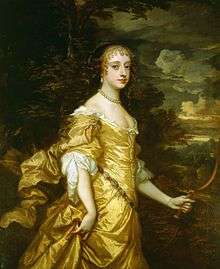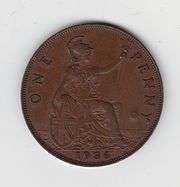Frances Stewart, Duchess of Richmond
Frances Teresa Stewart, Duchess of Richmond and Lennox (8 July 1647[1] – 15 October 1702) was a prominent member of the Court of the Restoration and famous for refusing to become a mistress of Charles II of England. For her great beauty she was known as La Belle Stuart and served as the model for an idealised, female Britannia.

Biography
Frances was the daughter of Walter Stewart, or Stuart, a physician in Queen Henrietta Maria's court, and a distant relative of the royal family. She was born on 8 July 1647 in exile in Paris, but was sent to England in 1663 after the restoration by Charles I's widow Henrietta Maria as maid of honour (a court appointment) and subsequently as lady-in-waiting to Charles II's new bride, Catherine of Braganza.[2]
The great diarist Samuel Pepys recorded that she was the greatest beauty he ever saw. She had numerous suitors, including the Duke of Buckingham and Francis Digby, son of the Earl of Bristol, whose unrequited love for her was celebrated by Dryden. Her beauty appeared to her contemporaries to be equalled only by her childish silliness; but her letters to her husband, preserved in the British Museum, are not devoid of good sense and feeling.
The Count de Gramont said of her that "it would be difficult to imagine less brain combined with more beauty."
While a member of the royal court, she caught the eye of Charles II, who fell in love with her. The king's infatuation was so great that when the queen's life was despaired of in 1663, it was reported that he intended to marry Stewart, and four years later he was considering the possibility of obtaining a divorce to enable him to make her his wife because she had refused to become his mistress.
Eventually, in March 1667, she married (as his third wife) Charles Stewart, 3rd Duke of Richmond, 6th Duke of Lennox (1639-1672), a 4th cousin of King Charles II, but produced no issue. It is possible she had to elope, after being discovered with him by Lady Castlemaine, a rival for the king's affections.
The now Duchess of Richmond, however, soon returned to court, where she remained for many years; and although she was disfigured by smallpox in 1669, she retained her hold on the king's affections. It is certain, at least, that Charles went on to post the Duke to Scotland and then to Denmark as ambassador, where he died in 1672.
The duchess was present in 1688 at the birth of James Francis Edward Stuart ("The Old Pretender"), son of James II, and was one of those who signed the certificate before the council. She died in 1702 aged 55, leaving a valuable property to her nephew Alexander Stuart, 5th Lord Blantyre, whose seat of Lethington was renamed Lennoxlove after her.
Britannia
Following the war with the Dutch, Charles had a commemorative medal cast, in which her face was used as a model for Britannia; this subsequently became customary for medals, coins and statues. She continued to appear on some of the copper coinage of the United Kingdom until the decimalization of the currency in 1971.[2] She also appeared on the fifty pence piece in 2006.
In fiction
- The Lady on the Coin, by Margaret Campbell Barnes & Hebe Elsna, pub. 1963.
- The Sceptre and the Rose Doris Leslie (1967)
- Forever Amber Kathleen Winsor (1944)
- The Painted Lady Maeve Haran
- Girl on the Golden Coin Marci Jefferson (2014)
- "Dark Stars" C.S. Quinn
Notes
- Encyclopædia Britannica
- "Britannia History: Frances Stuart, the Face of Britannia". www.britannia.com. Archived from the original on 1 February 2017. Retrieved 25 October 2016.
References
- "Hidden Past".CS1 maint: ref=harv (link)
- Attribution

- Gilbert Burnet, History of my own Time (6 vols., Oxford, 1833)
- Samuel Pepys, Diary, 9 vols. (London, 1893–1899, and numerous editions)
- Anthony Hamilton, Memoire of Grammont, translated by Boyer, edited by Sir W. Scott (2 vols., London, 1885, 1890)
- Anna Jameson, Memoirs of Beauties of the Court of Charles II, with their Portraits (2nd ed., London, 1838)
- Jules J. Jusserand, A French Ambassador at the Court of Charles II (London, 1892)
- Edmund Ludlow, Memoirs, 1625-72, edited by C. H. Firth (2 vols., Oxford, 1894)
External links
| Wikimedia Commons has media related to Frances Stewart, Duchess of Richmond and Lennox. |
